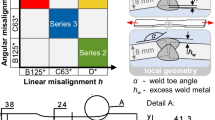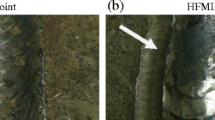Abstract
Many factors are involved in determining the fatigue strength of welded joints. It is, however, very difficult to consider their relative importance. The aim of this paper is to isolate the effect of residual stress from other factors, establishing a relation between the amount of residual stress and fatigue life. A geometrical notch due to the weld bead is removed by milling the upper surface of the welded plates. Moreover, specimens are subjected to four-point bend loading. Before conducting the fatigue test, the magnitude of residual stress for each specimen is experimentally evaluated, and then linked to the number of cycles to failure. This relation is analyzed for three different plate thicknesses and for different stress amplitude levels in the high cycle regime. The results clearly show the significant influence of residual stress on fatigue behaviours when the load level is near the fatigue limit.
Similar content being viewed by others
References
R. I. Stephens, A. Fatemi, R. R. Stephens and H. O. Fuches, Metal fatigue in engineering, John Wiley & Sons 2001.
E. Zahavi and V. Torbilo, Fatigue design and life expectancy of machine parts, CRC Press 1996.
H. P. Lieraude, Rôle des contraintes résiduelles dans le comportement en fatigue des composants soudés, Journées Scientifiques et Techniques’97 “Durabilité des Matériaux de Structures”, 3–4 Novembre 1997, Nabeul (Tunisie).
D. G. Bellow, M. A. Wahab and M. G. Faulkner, Residual stresses and fatigue of surface treated welded specimens, Advance in surface treatments; 2 (1986) 85–94.
N. T. Nguyen and M. A. Wahab, The effect of undercut and residual stresses on fatigue behaviour of misaligned butt joints, Engineering fracture mechanics; 55(3) (1996) 453–469.
Sarkani, Shahram, Michaelov, George, Kihl and P. David, Stochastic fatigue damage accumulation in a T-welded joint accounting for the residualstress fields, International Journal of Fatigue; 23(1) (2001) 71–78.
M. Chiarelli, A. Lanciotti and M. Sacchi, Fatigue resistance of MAG welded steel elements, International Journal of Fatigue; 21(10) (1999) 1099–1110.
G. A. Webster and A. N. Ezeilo, Residual stress distributions and their influence on fatigue lifetimes, International Journal of Fatigue; 23(1) (2001) 375–383.
K. Masubuchi, Analysis of welded structures, Pergamon Press, USA, 1980.
T. R. Gurney, Fatigue of welded structures, Cambridge University Press, Cambridge, 1979.
S. Maddox, Fatigue strength of welded structures, Abington Publishers, Cambridge, 1991.
D. Radaj and C. M. Sonsino, Fatigue assessment of welded joints by local approach, Abington Publishing, 1998.
W. H. Munse, Fatigue of weldments — tests, design and service, Fatigue Testing of Weldments — ASTM STP 648 (Hoeppner D.W. editor), ASTM, 1978; 89–112.
M. Ros, La fatigue des soudures, Rev. Métallurgie, n.11 (1948).
F. Hebrant, H. Louis, W. Soete and A. Vinckier, The relaxation of residual welding stress by static and fatigue loading, Welding Research Abroad, (1957) 58–63.
D. S. Dugdale, Effect of residual stress on fatigue strength, Welding Jnl.; Research Suppl., 38(1) (1959) 45–48.
G. Casalino, M. De Giorgi, R. Nobile and F. W. Panella, Valutazione delle tensioni residue e della resistenza a fatica di lamiere piegate termicamente al laser, Proc. of the XXXI Nat. Conf. AIAS, Parma, 18–21 September 2002.
V. Dattoma, M. De Giorgi and F. W. Panella, Experimental and numerical evaluation of residual stresses and effect on fatigue life for longitudinal joints, Proc. Of the New trends in fatigue and fracture, Metz (Francia) 8–9 April 2002.
M. De Giorgi, Valutazione numerica e sperimentale delle tensioni residue in giunzioni saldate ed effetto sulla resistenza a fatica, Ph.D Thesis, 2002.
V. Dattoma, M. De Giorgi and R. Nobile, On the evolution of the welding residual stress after milling and cut machining, Computers and Structures, 84 (2006) 1965–1976.
V. Dattoma, M. De Giorgi and R. Nobile, On the residual stress and the fatigue resistance of butt-welded joints, International Conference on Experimental Mechanics 12, Bari, Italy. 2004.
E. K. Henriksen, Residual stresses in machined surfaces, Trans. ASME, 73 (1951) 69–76.
M. M. El-Khabeery and M. Fattouh, Residual stress distribution caused by milling, Int. J. Mach. Tools Manuf., 29(3) (1989) 391–401.
K. Jacobus, S. G. Kapoor and R. E. DeVor, Experimentation on the Residual Stresses Generated by Endmilling, J. Manuf. Sci. Eng., 123 (2001) 748–753.
K. Jacobus, R. E. DeVor and S. G. Kapoor, Machining-Induced Residual Stress: Experimentation and Modeling, J. Manuf. Sci. Eng., 122 (2000) 20–31.
T. Berruti and G. Ubertalli, Influence of cutting parameters on residual stresses induced by milling in pressure die-cast aluminium alloy components, J. Manu. Sc. Eng., 123(4) (2001) 547–551.
F. Ghanem, C. Braham, M. Fitzpatrick and H. Sidhom, Effect of near-surface residual stress and microstructure modification from machining on the fatigue endurance of a tool steel, Journal of Materials Engineering and Performance; 11(6) (2002) 631–639.
Kuang-Hua Fuh and Chih-Fu Wu, A residual-stress model for the milling of aluminium alloy (2014-T6) Journal of Materials Processing Technology, 51(1–4) (1995) 87–105.
P. Chevrier, A. Tidu, B. Bolle, P. Cezard and J. P. Tinnes, Investigation of surface integrity in high speed end milling of a low alloyed steel, International Journal of Machine Tools & Manufacture; 43(11) (2003) 1135–1142.
G. S. Schajer, Application of Finite Element Calculation to Residual Stress Measurement, Journal of Engineering Materials and Technology, 103 (1981) 157–163.
G. S. Schajer, Strain Data Averaging for the Hole-Drilling Method, Experimental Techniques, (1991) 25–28.
M. Beghini, L. Bertini and P. Raffaelli, Numerical analysis of plasticity effects in the hole-drilling residual stress measurement, Journal of Testing and Evaluation, 22(6) (1994) 522–529.
K. Sasaki, M. Kishida and T. Itoh, The Accuracy of Residual Stress Measurement by the Hole-drilling Method, Experimental Mechanics, 37(3) (1997) 250–257.
R. Ottel, The Determination of Uncertainties in Residual Stress Measurement (Using the hole drilling technique), Standard Measurement & Testing Project No. SMT4-CT97-2165, Issue 1, (2000).
K. Iida, S. Yamamoto and M. Takanashi, Residual stress relaxation by reversed loading, Welding in the World / Le Soudage dans le Monde; 39(3) (1997) 138–144.
S. J. Maddox, Influence of tensile residual stresses on the fatigue behaviour of welded joints in steel, ASTM STP 776, (1982) 63–96.
S. Berge and O. I. Eide, Residual stress and stress interaction in fatigue testing of welded joints, ASTM STP 776, (1982) 115–131.
D. V. Nelson, Effect of residual stress on fatigue crack propagation, residual stress effects in fatigue, ASTM STP 776, (1982) 172–194.
V. Dattoma, M. De Giorgi and R. Nobile, Influenza delle tensioni residue sul comportamento a fatica di giunti saldati di testa, Proc. of the XXXII Nat. Conf. AIAS, Salerno, 3–6 September 2003.
V. Dattoma, M. De Giorgi and R. Nobile, Numerical evaluation of residual stress relaxation by cyclic load, Journal of Strain Analysis, 39(6) (2004) 663–672.
Author information
Authors and Affiliations
Corresponding author
Additional information
This paper was recommended for publication in revised form by Associate Editor Chongdu Cho
Marta De Giorgi received her masters’ degree and Ph.D. degree in Materials Engineering from Lecce University in 1998 and 2002, respectively. She is currently a Post-Doctoral researcher at Salento University in Lecce, Italy. Dr. De Giorgi’s research interests are in the areas of fatigue, residual stress, welded joints, and advanced materials. She studies these subjects through experimental and numerical means.
Riccardo Nobile is a researcher in Machine Design at University of Salento. His principal research interests include the fatigue behaviour of base and welded materials, the development of experimental methods to evaluate and monitoring fatigue damage, the experimental and numerical study of residual stress, and the mechanical characterisation of advanced materials.
Vito Dattoma is a full-professor of Machine Design at University of Salento. His research interests are in materials mechanical behaviours under static and dynamic loads, the experimental and numerical structural analysis of industrial components, the mechanical characterization of aeronautical super-alloys, and the fatigue design of welded structures. Prof. Dattoma is currently the Dean of the Engineering Faculty at University of Salento.
Rights and permissions
About this article
Cite this article
De Giorgi, M., Dattoma, V. & Nobile, R. Some considerations about fatigue failure in milled butt-welded joints affected by residual stress. J Mech Sci Technol 24, 453–460 (2010). https://doi.org/10.1007/s12206-009-1280-9
Received:
Revised:
Accepted:
Published:
Issue Date:
DOI: https://doi.org/10.1007/s12206-009-1280-9




